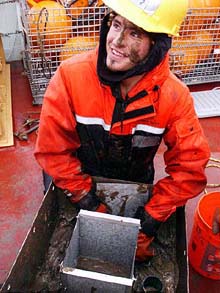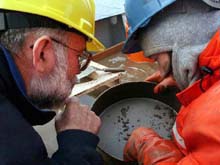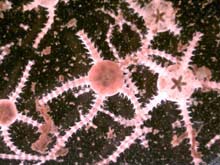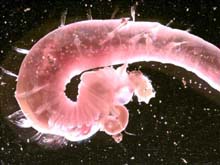
Casey Debenham, a master's student at the University of Alaska, processes a box core sample. By the time he was finished, he made sure the rest of the benthic team were covered in mud! Click image for larger view.

After sieving a portion of the benthic sample, Terry Whitledge and Bodil Bluhm search for hidden animals. Click image for larger view.
Excavating Buried Treasure
August 17, 2002
Casey Debenham
University of Alaska Fairbanks
An opportunity to participate in an exploratory cruise in the Arctic does not come along every day, particularly for a master’s student. So I jumped at the chance when my graduate advisor at the University of Alaska Fairbanks (UAF) suggested the idea a few weeks ago.
My adventure started in Fairbanks at about 11 pm on Aug. 12. We were waiting in line with great anticipation for the journey ahead of us. Little did we know that our final destination, the Canadian Coast Guard Ship Louis St. Laurent, was still several thousand miles and quite a few hours away. By the time I finally set foot on the Louis, it was 5 am on Aug 14 -- almost 30 hrs after I left home. The next few days were spent getting a well-needed rest, exploring the vessel, and familiarizing myself with some of the many intriguing projects. Since this is my first large-scale scientific cruise, everything holds fascination for me.
On board the Louis, Bodil Bluhm of UAF, Ian McDonald from Texas A&M, and I make up the benthic biology group. Our job is to collect as much information as we can on the biology at the bottom of the ocean. Due to the nature of our work, everyone on board has dubbed us the "mud people." Our main collection methods include a bottom grab called a box core, as well as some ROV (remotely operated vehicle) work. The box core is an oceanographic tool that is lowered to the sea floor by a cable attached to the ship’s winch. When it hits the bottom, it grabs a 0.25-m- square chunk of the ocean floor. The winch brings the box core back to the surface, where we sieve through the mud and pick out animals.
Today, Aug. 17th, was the first day that we deployed the box core to look at deep-sea benthic (bottom) biology. Our first station was at a relatively shallow depth of 600 m. It was the first time we had worked with this particular box core, so it took a while to get used to and deploy. The cable also took a long time to reach the bottom because the crew wanted to make sure things were in proper working order.
Several hours later, we watched as the box core rose from the depths. With a shout of joy, we saw the mud trail behind it. Success! The box core was brought aboard and we proceeded to take several subsamples. This included a 0.04- m-square area for quantitative analysis, a small core for meiofauna work, and several sediment surface layers for analysis. We then had fun getting extremely muddy. We scooped the mud into buckets for sieving and shoveled the leftover, deeper clay sediment overboard. All sediment below 10 cm is usually disregarded, because the biota usually occurs in only the top 5-10 cm.
The following few hours of sieving seemed to take an eternity. To reduce the amount of mud tracked around the boat, we set up a sieve table on the bow. The wind started to pick up as we motored by an occasional iceberg. Three hrs later, as we were finishing up, the wind speed had reached a bone-chilling 30+ knots. We were cold, dirty, and wet, but overall, we were in a really good mood. The fire hose was turned on and we sprayed off the mud, both from the ship and ourselves. Most importantly, we had a jar full of specimens. It was time to head to the lab.
Under the dissecting scope, we managed to find some very interesting creatures. A handful of brittlestars crawled through the sediment. We also found many worms, most of them less than 2 cm in length. The longest worm we found measured almost 7 cm. We also discovered several small bivalves in addition to a few different types of crustaceans. We will use many of the things we collect as vouchers, preserved specimens that we will identify back in Fairbanks after the cruise.
To the best of our knowledge, we are the first group to do benthic box cores in the Canada Basin. For this reason, we are trying to make sure that we collect a good representation of life in the depths. If possible, we will also take tissue samples for stable isotope and pollutant analysis. The isotopes will help us to figure out a portion of the structure of the food web, including what the main energy source is. The pollutants are of interest so we can get an idea of how people, particularly those of us living far away, are affecting an area about which we currently know very little.
Over the next few weeks, we plan to work our way down the slope of the Canada Basin, eventually getting samples from depths of more than 3,000 m. We also hope to collect samples from both sides of the Canada Basin to get some overall insight into life in the deep Arctic Ocean.
Sign up for the Ocean Explorer E-mail Update List.




























